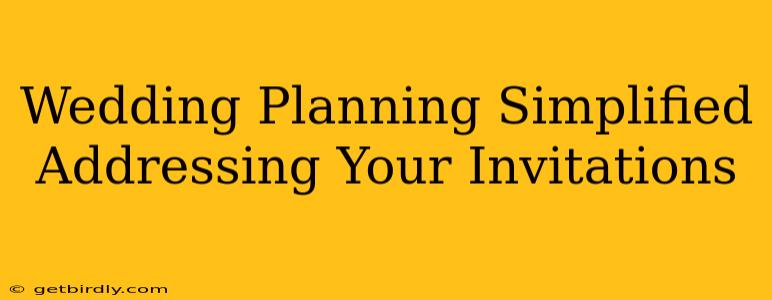Wedding Planning Simplified: Addressing Your Invitations
Wedding invitations are more than just pretty paper; they're the first official communication to your guests, setting the tone for your entire celebration. Addressing them correctly, however, can feel surprisingly daunting. This guide simplifies the process, covering etiquette, addressing styles, and tips to make the task less overwhelming.
What's the Proper Etiquette for Addressing Wedding Invitations?
Traditional etiquette dictates a level of formality for wedding invitations. While modern weddings often embrace a more relaxed style, understanding the basics ensures your guests feel respected and valued. The key is to be consistent and accurate in your addressing.
The Main Invitation: The outer envelope should be addressed formally, using titles (Mr., Mrs., Ms., Dr.) and full names. Avoid nicknames unless you're on very familiar terms with the recipient. For couples, use "Mr. and Mrs. [Last Name]" or "Ms. [Last Name] and Mr. [Last Name]" depending on the couple's preference.
Inner Envelope: The inner envelope is slightly less formal. You can use first names here if you're comfortable, especially for close friends and family. However, maintaining consistency with the outer envelope is also acceptable.
Addressing Multiple People:
- Married Couple: "Mr. and Mrs. [Last Name]"
- Unmarried Couple: "Ms. [Last Name] and Mr. [Last Name]" (or list each individually if they prefer)
- Family: "The [Family Last Name] Family" or list each adult individually, followed by their children's names. Example: "Mr. and Mrs. John Smith and Children" or "Mr. John Smith, Mrs. Jane Smith, Emily Smith, and Thomas Smith".
- Single Guest: Use their full name, including title if applicable.
How to Address Wedding Invitations for Different Scenarios?
Addressing invitations can get tricky with various situations. Let’s address some common scenarios:
How do I address a wedding invitation to a couple who lives together but isn't married?
The most respectful approach is to address the invitation to both individuals using their full names: "Ms. [Last Name] and Mr. [Last Name]". Avoid using "Mr. and Ms." as this implies marriage.
What about children? Should I include their names on the invitation?
This depends largely on your relationship with the family and whether children are included in the wedding celebration. If children are explicitly invited and will be attending the ceremony and/or reception, include their names. Otherwise, it's generally acceptable to omit their names.
How should I address invitations to close friends who prefer to go by nicknames?
If you and your guest share a close relationship and they commonly use a nickname, using their nickname is perfectly acceptable on the inner envelope. However, still use their formal name and title on the outer envelope.
What about guests with multiple last names (hyphenated or otherwise)?
Use the name they use most often and consistently. If they use a hyphenated last name, use the hyphenated version.
Tips for Simplifying the Addressing Process
Addressing hundreds of invitations can be overwhelming. Here are some tips to simplify the task:
- Create a Spreadsheet: Organize your guest list in a spreadsheet with the correct names and addresses. This allows you to easily copy and paste information onto your envelopes.
- Use Address Labels: While some prefer handwritten addresses for a personal touch, address labels save significant time and effort, especially for large guest lists.
- Request Addresses in Advance: Include a line on your RSVP card requesting guests' full names and addresses to avoid last-minute scrambling.
- Enlist Help: Don't be afraid to ask friends or family to assist with addressing envelopes. Make it a fun, social activity!
Addressing your wedding invitations correctly reflects respect for your guests and sets a formal yet warm tone for your wedding day. By following these guidelines and utilizing helpful tips, you can make the process much less stressful and focus on the excitement of planning your special day.

